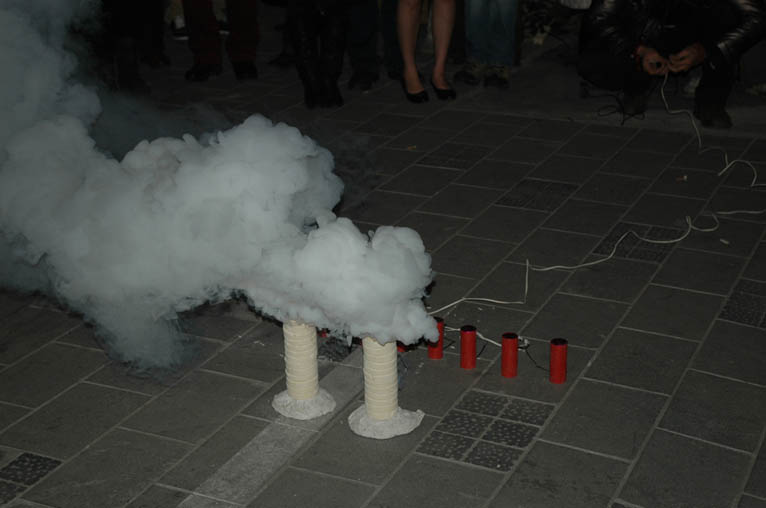MAKE OVER
| April 1, 2010 | Post In LEAP 2

On Shanghai’s Shaoxing Road, a comparatively “made-over” street, Oriental Vista Gallery has put on the fifteen-artist group show “Make Over.” The show’s Chinese name translates directly as “The Facade Project”; for Chinese readers, mention of the word “facade” will conjure up knowing smiles and abundant associations that do not stop at architecture. I could of course describe the exhibition piece by piece, but the curator has already done this and reviewing art in this way opens one up to accusations of standardized, stereotypical writing, what in Chinese is called bagu or “eight-legged, a prose form once required by the imperial examinations. While an art review itself should not be “eight-legged,” it can perhaps critique the “eight-leggedness” it sees, and if nothing else, this exhibition seems to prove the emergence of a standardized, “eight-legged” model for exhibitions these days.
Curator Rebecca Catching noticed that just as Beijing “welcomed” the Olympics and as Shanghai currently prepares to “welcome” the World Expo, people have painted over their walls and replaced wall bricks and paving stones, even those in otherwise good shape. And yet while the Expo is very clearly the pretext, one was often hard-pressed to see what relationship the concept of “facade” held to the context of the Expo; in the theoretical interpretation that contemporary art exhibitions cannot do without these days, the Expo does not seem to deepen the level of discussion. This can only be because the question of facade, whether understood in its narrow meaning pertaining to architecture or its broader societal implications, exists independently from the Expo. In other words, the question of facade is a good one, raw conceptual material definitely suitable for contemporary artistic discourse. And it is just as incisive without needing to use the Expo as a pretense.
Taking a topic this conceptually rich but insisting on using an immediate, grand and vague event as its starting point is standard “eight-legged” procedure. As pertains to contemporary art exhibitions, this operating method includes the expectation that the artwork should use as many media and forms as possible. In this respect “Make Over” is very much up to code, the types of artwork including textual collage, photography, multimedia, installation, readymades and performance.
Of course an “eight-legged” show also cannot do without a catalogue containing both theoretical interpretations and artwork descriptions, the two largely separate from each other. The function of the catalogue is this: it sufficiently distracts visitors from looking at the artwork while also allowing enthusiasts unable to visit the gallery to feel intimate and familiar, as if they comprehend the show. Take, for an example, the catalogue’s pronouncement on Qiu Anxiong’s work: Smoke (2009-2010), points to issues of transparency through the act of setting off a smoke bomb outside the gallery. Much of the Expo renovations are happening behind walls and scaffolding—we know very little about the inner workings of this great branding machine.” In another example, the catalogue has this to say about the artist collective Birdhead’s photocollage Tang Poem (2010): “Birdhead’s work reverses the Expo paradigm of turning old into new by turning new (Chinese vernacular typography) into old, forging a link through language with their Tang ancestors.”
“Eight-legged” art is met with general reproach, but “eight-legged” curating does not seem to elicit the same harsh verdicts. On some level this signifies that contemporary art has amassed its own audience, albeit a hermetic one. Chinese intellectuals often lament that for all the failings of the “eight-legged” essays, no great masters of traditional thought have emerged since the imperial examinations were eliminated in 1901. Seen in another way, among the many valences of the word “facade” in the show’s Chinese title, perhaps the most prominent is that of “standardization.” And in embodying a standardized, “eight-legged” curatorial model, the show succeeds in attaining a sort of hermeneutic consistency. Hu Yuanxing

